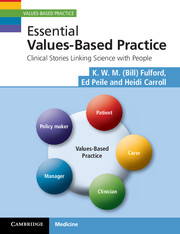Book contents
- Frontmatter
- Review quotes
- Contents
- Foreword
- Acknowledgements
- A bold claim to start this book
- Prologue: linking science with people
- Part 1 Values, individuals and an overview of values-based practice
- Part 2 The clinical skills for values-based practice
- Part 3 Relationships in values-based practice
- Part 4 Science and values-based practice
- Part 5 Bringing it all together
- Postcript: the small change of care
- A bold claim to end this book
- Appendix A Values-based practice summary and definitions of key terms
- Appendix B Values-based practice teaching framework
- Index
Postcript: the small change of care
Published online by Cambridge University Press: 05 June 2012
- Frontmatter
- Review quotes
- Contents
- Foreword
- Acknowledgements
- A bold claim to start this book
- Prologue: linking science with people
- Part 1 Values, individuals and an overview of values-based practice
- Part 2 The clinical skills for values-based practice
- Part 3 Relationships in values-based practice
- Part 4 Science and values-based practice
- Part 5 Bringing it all together
- Postcript: the small change of care
- A bold claim to end this book
- Appendix A Values-based practice summary and definitions of key terms
- Appendix B Values-based practice teaching framework
- Index
Summary
The stories in this book have illustrated some of the ways in which the skills and other process elements of values-based practice support balanced decision-making in medicine and health care where complex and conflicting values are in play.
As a response to complexity, values-based practice, as we have emphasized throughout, is a partner to evidence-based practice. Decisions – all decisions, whether clinical or otherwise – stand, as we put it in Chapter 1, on two feet, a values foot and an evidence foot. The process of evidence-based practice has been developed as a response to the growing complexity of the evidence base of clinical decision-making. The process of values-based practice has been developed as a response to the growing complexity of the values base of clinical decision-making.
Linking science with people
The complementary relationship between evidence-based practice and values-based practice can be understood in part in terms of the relationship between the sciences and the humanities.
There are overlaps, of course. The founders of evidence-based practice, as we saw from David Sackett's work in Part 1, although focusing on the technical processes required for establishing generalizable conclusions about best scientific evidence, set this in context with the need to link best evidence with clinical experience and patients' values. Values-based practice similarly, although derived primarily from work in analytic and other areas of philosophy, includes knowledge of values (including as we described in Chapter 6, research-based knowledge) as one of its four key skills areas; and the process elements of values-based practice include three specific principles (covered in Part 4) directly linking evidence and values.
Information
- Type
- Chapter
- Information
- Essential Values-Based PracticeClinical Stories Linking Science with People, pp. 201 - 203Publisher: Cambridge University PressPrint publication year: 2012
